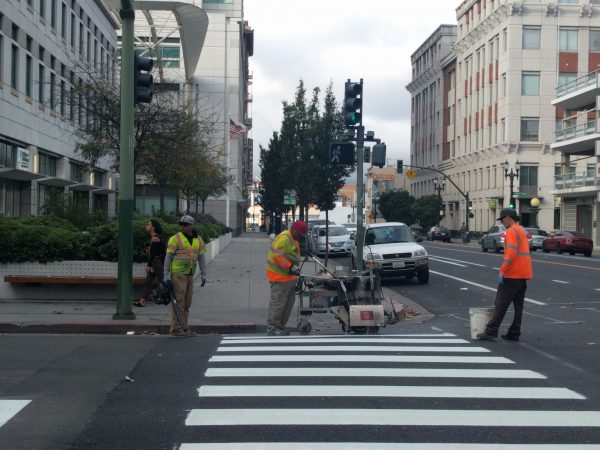The first documented use of a hand-painted center line in the United States dates back to 1911. As the story goes, a Board of Roads chairman in Michigan named Edward N. Hines was inspired to its invention when he spotted a leaky milk truck leaving a strip of white on the road. Today, US roadways sport millions of miles of paint from coast to coast, most of it applied somewhat more professionally.
As the above video illustrates, many talented painters can still create both lines and curves freehand with remarkable speed and control. A manual approach can be particularly useful for small and complex designs, though stencils and tools can help as well. But just as street lettering performed without mechanical aid can be enchanting, so too can watching skilled and speedy operators of road marking machines.
Along those lines, the expert stripe painter in the video above has a lot more ground to cover than a symbol or word maker. They also have to be precise both in terms of vehicle position and spray timing. Having the machine store and deploy paint on demand clearly helps, but the ability of the operator to work so fast is nonetheless compelling.
In the above explainer, the driver is a bit hard to hear over the sound of his parking lot striping machine, but it doesn’t matter: actions speak louder than words as he drives flawlessly back and forth applying paint. Notably, the ability of the vehicle to arc smoothly also helps the driver paint curved lines (as shown starting around the 2:30 mark).
If you can get past a somewhat sloppier technique and a rather strange soundtrack, this tutorial montage illustrates how roadside curbs can also be painted with human-guided machines. As designers like to say, the project can be done fast, good and/or cheap: pick two.
At the heart of these various tasks (at least for now) is a synergy of human and machine — a skilled operator and a precision device. Eventually, automation may render operators obsolete, but for now: there are good reasons for actual people to keep an eye on things.
Finally, no urban road painting article would be complete without featuring this incident in Tel Aviv, in which a city worker was caught on camera turning an ordinary parking space into a handicap spot while a car was legally parked in the space. The owner of the vehicle, a local resident, found proof thanks to a camera across the street and the city later issued an apology. To be fair to the painter, though: at least they did a pretty good job on the symbol itself (even with a car in the way).
So the next time you see something painted on the road, stop for a second to wonder: just how did they do that, anyway?




Comments (2)
Share
I’ve always been amazed at the skill of those who regularly paint the roads for us. It’s a dangerous and difficult job. The paint job that most amazed me, that I saw many decades ago was in Germany, was where I saw a worker digging out the asphalt at an intersection and replacing it with a white “asphalt” stop bar that would not wear away. I’ve never seen anything like it since. I guess it is just not cost efficient to do things like that and the annual painting we see going on is just a part of having roads and highways.
An hour after reading this I saw a worker with a machine painting lines in a hospital parking lot. I took a few minutes to just watch and enjoy.